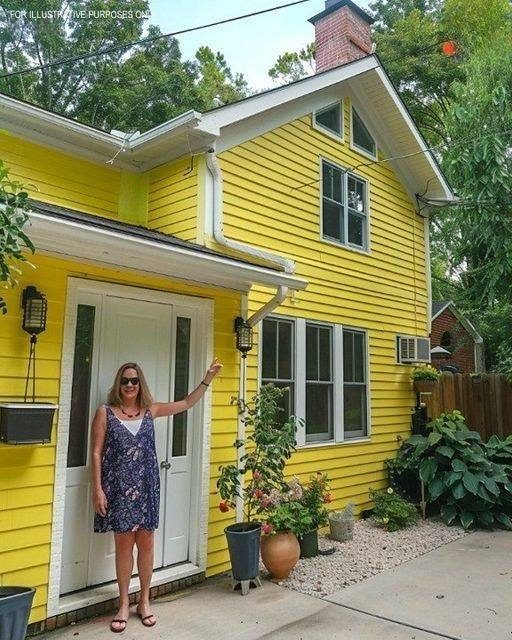When Victoria returned home from a two-week vacation, she was met with a sight that made her heart drop. Her once vibrant yellow house—a cherished symbol of love and memories painted by her late husband—had been coldly transformed into a dull gray. The bright color that had once made her home stand out in the neighborhood was now replaced by something sterile and lifeless. Victoria stood frozen in disbelief, her stomach churning with anger and heartbreak. This wasn’t just paint; it was an erasure of something deeply personal.

She didn’t need to think long to suspect who was behind it. Her neighbors, the Davises, had always been vocal about their distaste for her home’s sunny hue. They had made snide remarks at every chance, muttering about “neighborhood standards” and how her home was an eyesore. But despite their criticisms, Victoria had held her ground, knowing the yellow represented more than just aesthetics—it was a tribute to her late husband’s vibrant spirit. Yet, while she was away, they had taken matters into their own hands, crossing a line that could never be uncrossed.
Fueled by righteous anger, Victoria marched over to confront the Davises. They opened their door with expressions that ranged from feigned confusion to outright indifference. “We don’t know what you’re talking about,” Mrs. Davis said with a practiced smile, while Mr. Davis stared at the ground, refusing to meet Victoria’s furious gaze. But Victoria wasn’t buying their act. She knew they were lying, and she was determined to get to the bottom of it.
Victoria turned to her other neighbor, Mr. Thompson, a kind older gentleman who had always been observant and fair. What he told her left her stunned. The Davises had forged a work order in their name, hired a painting crew, and instructed them to repaint Victoria’s house while she was away. Hearing the details only made Victoria’s fury burn hotter. This wasn’t just meddling—it was calculated deceit.
Determined to fight back, Victoria headed straight to the painting company responsible for the job. At their office, she met with the manager, Gary, who listened to her story with a look of growing horror. “We genuinely thought it was their house,” Gary said apologetically. “They had all the paperwork, and everything seemed legitimate.” But an apology wasn’t enough for Victoria. She wasn’t going to let this slide. She insisted on legal action, and Gary, realizing the gravity of the situation, agreed to cooperate fully.
The case went to court, and Victoria’s anger turned into focused determination. In the courtroom, the workers from the painting company testified, confirming that the Davises had provided forged documents and posed as the owners of Victoria’s home. The Davises sat stiffly in their seats as the evidence stacked against them, their earlier confidence melting away under the weight of undeniable proof.
The judge delivered a clear and firm verdict: the Davises were guilty of fraud and vandalism. They were ordered to repaint Victoria’s home back to its original vibrant yellow at their own expense and cover all legal and court fees. Justice had been served, but for Victoria, it was more than just a legal victory—it was personal. Her home, her husband’s legacy, was about to be restored.
As they exited the courthouse, Mrs. Davis couldn’t resist one final jab. With a venomous sneer, she hissed, “I hope you’re happy now.” But Victoria, calm and composed, met her gaze with a sweet smile and replied, “I will be—when my house is YELLOW again!”
The repainting began shortly after the ruling. Victoria stood outside her home every day, watching each brushstroke return her house to the bright, joyful yellow it was meant to be. It wasn’t just paint being restored; it was her husband’s memory, her sense of home, and her pride. Neighbors who had once stayed silent started to come forward, offering kind words and support. Even strangers who heard her story praised her resilience and determination.
In the end, the Davises’ scheme had spectacularly backfired. Their attempt to erase something they didn’t like had only shone a spotlight on their pettiness and cruelty. Meanwhile, Victoria stood tall, her yellow house glowing under the sunlight like a beacon of resilience and love.
For Victoria, this was never just about paint. It was about honoring her husband’s memory, defending her rights, and refusing to be bullied into silence. Every time she looked at her house, now proudly yellow once again, she felt peace and satisfaction. Her home was more than just a building—it was a symbol of love, perseverance, and victory over those who sought to diminish her joy.





